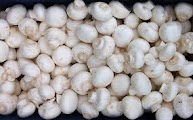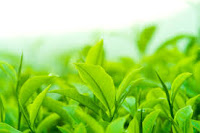A mushroom (or toadstool) is the fleshy, spore-bearing fruiting body of a fungus, typically produced above ground on soil or on its food source.
The standard for the name "mushroom" is the cultivated white button mushroom, Agaricus bisporus; hence the word "mushroom" is most often applied to those fungi (Basidiomycota, Agaricomycetes) that have a stem (stipe), a cap (pileus), and gills (lamellae, sing. lamella)
on the underside of the cap. These gills produce microscopic spores
that help the fungus spread across the ground or its occupant surface.
"Mushroom" describes a variety of gilled fungi, with or without
stems, and the term is used even more generally, to describe both the
fleshy fruiting bodies of some Ascomycota and the woody or leathery fruiting bodies of some Basidiomycota, depending upon the context of the word.
Forms deviating from the standard morphology usually have more specific names, such as "bolete", "puffball", "stinkhorn", and "morel", and gilled mushrooms themselves are often called "agarics" in reference to their similarity to Agaricus or their order Agaricales. By extension, the term "mushroom" can also designate the entire fungus when in culture; the thallus (called a mycelium) of species forming the fruiting bodies called mushrooms; or the species itself.
Mushrooms are a low-calorie food eaten cooked, raw or as a garnish to a meal. In a 100 g (3.5 ounce) serving, mushrooms are an excellent source (higher than 20% of the daily value, DV) of B vitamins, such as riboflavin, niacin and pantothenic acid, an excellent source of the essential minerals, selenium (37% DV) and copper (25% DV), and a good source (10-19% DV) of phosphorus and potassium. Fat, carbohydrate and calorie content are low, with absence of vitamin C and sodium. There are 27 calories in a typical serving of fresh mushrooms (table).
When exposed to ultraviolet (UV) light even after harvesting, natural ergosterols in mushrooms produce vitamin D2, a process now used to supply fresh vitamin D mushrooms for the functional food grocery market.
In a comprehensive safety assessment of producing vitamin D in fresh
mushrooms, researchers showed that artificial UV light technologies were
equally effective for vitamin D production as in mushrooms exposed to
natural sunlight, and that UV light has a long record of safe use for production of vitamin D in food.
Mushrooms are used extensively in cooking
Mushrooms are used extensively in cooking, in many cuisines (notably Chinese, Korean, European, and Japanese). Though neither meat nor vegetable, mushrooms are known as the "meat" of the vegetable world.
Most mushrooms sold in supermarkets have been commercially grown on mushroom farms. The most popular of these, Agaricus bisporus, is considered safe for most people to eat because it is grown in controlled, sterilized environments. Several varieties of A. bisporus are grown commercially, including whites, crimini, and portobello. Other cultivated species available at many grocers include Hericium erinaceus, shiitake, maitake (hen-of-the-woods), Pleurotus, and enoki.
In recent years, increasing affluence in developing countries has led
to a considerable growth in interest in mushroom cultivation, which is
now seen as a potentially important economic activity for small farmers.
A number of species of mushrooms are poisonous;
although some resemble certain edible species, consuming them could be
fatal. Eating mushrooms gathered in the wild is risky and should only be
undertaken by individuals knowledgeable in mushroom identification.
Common best practice is for wild mushroom pickers to focus on collecting
a small number of visually distinctive, edible mushroom species that
cannot be easily confused with poisonous varieties. A. bisporus contains small amounts of hydrazines, the most abundant of which is agaritine. However, the hydrazines are destroyed by moderate heat when cooking.
More generally, and particularly with gilled mushrooms, separating
edible from poisonous species requires meticulous attention to detail;
there is no single trait by which all toxic mushrooms can be identified,
nor one by which all edible mushrooms can be identified. Additionally,
even edible mushrooms may produce allergic reactions in susceptible individuals, from a mild asthmatic response to severe anaphylactic shock.
People who collect mushrooms for consumption are known as mycophagists,and the act of collecting them for such is known as mushroom hunting, or simply "mushrooming".
China is a major edible mushroom producer.
The country produces about half of all cultivated mushrooms, and around
2.7 kilograms (6.0 lb) of mushrooms are consumed per person per year by
over a billion people. In 2014, Poland was the world's largest mushroom exporter, reporting an estimated 194,000 tonnes annually.
Medicinal properties
Some mushrooms or extracts are used or studied as possible treatments for diseases, including polysaccharides, glycoproteins and proteoglycans.Currently, several extracts have widespread use in Japan, Korea and
China, as adjuncts to radiation treatments and chemotherapy, even though clinical evidence of efficacy in humans has not been confirmed.
Historically, mushrooms have been thought to hold medicinal value in traditional Chinese medicine.They have been studied in modern medical research since the 1960s,
where most studies use extracts, rather than whole mushrooms.
In some countries, extracts of polysaccharide-K, schizophyllan, polysaccharide peptide, or lentinan are government-registered adjuvant cancer therapies.
Mushrooms can be used for dyeing wool and other natural fibers. The chromophores of mushroom dyes
are organic compounds and produce strong and vivid colors, and all
colors of the spectrum can be achieved with mushroom dyes. Before the
invention of synthetic dyes, mushrooms were the source of many textile dyes.
Some fungi, types of polypores loosely called mushrooms, have been used as fire starters (known as tinder fungi).
Mushrooms and other fungi play a role in the development of new biological remediation techniques (e.g., using mycorrhizae to spur plant growth) and filtration technologies (e.g. using fungi to lower bacterial levels in contaminated water).

























